Stress Distribution in Microregion of Core–Shell Structure Lightweight Aggregate Concrete
Abstract
:1. Introduction
2. Modeling and Simulation
2.1. Experimental Basis of Model Establishment
2.2. Methodology
2.3. Material Parameters
3. Results and Discussion
3.1. Influences of Characteristics of CSLWA on Stress Distribution in Microregion of LWAC
3.1.1. Components of the Core
3.1.2. Core–Shell Thickness Ratio
3.1.3. Core–Shell Interfacial Bonding Zone
3.2. Influences of ITZ Properties on Stress Distribution in Microregion of LWAC
3.2.1. Equivalent Treatment of ITZ
3.2.2. Variation of Microregion Stress Distribution
4. Conclusions
- (1)
- The mineral composition of the core significantly influences the stress distribution in the microregion close to the shell of core–shell structure LWAC. Under the condition of constant porosity, when the content of high-modulus components increases, the minimum stress location in the model is gradually transferred from the core–shell interface to the interface between the shell and cement matrix. Moreover, the stress difference between the core and shell is intensified, which increases the possibility of nucleation and the propagation of microcracks at the interface.
- (2)
- The core–shell thickness ratio primarily affects CSLWA stress distribution on the shell. With the increase of core–shell thickness ratio, the stress difference on the shell increases, and the more uneven stress distribution likely leads to the nucleation and extension of microcracks on the shell. Furthermore, IBZ can reduce the stress difference of the core–shell interface and can delay the local failure in LWAC.
- (3)
- Compared to the ordinary LWAC of the same grade, the stress distribution in the microregion close to the shell of the core–shell structure LWAC is more uniform. Moreover, an increase in the hydration age generates similar effects. These findings demonstrate that the CSLWA acts as a potential candidate to improve the failure resistance of LWAC.
Author Contributions
Funding
Institutional Review Board Statement
Informed Consent Statement
Data Availability Statement
Conflicts of Interest
References
- Korolev, E.V.; Inozemtcev, A.S. Preparation and research of the high-Strength lightweight concrete based on hollow microspheres. Adv. Mater. Res. 2013, 746, 285–288. [Google Scholar] [CrossRef]
- Mo, K.H.; Goh, S.H.; Alengaram, U.J.; Visintin, P.; Jumaat, M.Z. Mechanical, toughness, bond and durability-related properties of lightweight concrete reinforced with steel fibres. Mater. Struct. 2017, 50, 1–14. [Google Scholar] [CrossRef]
- Al-Khaiat, H.; Haque, M.N. Effect of initial curing on early strength and physical properties of a lightweight concrete. Cem. Concr. Res. 1998, 28, 859–866. [Google Scholar]
- Fang, C.Q.; Yi, M.Y. Seismic Performance of a Reinforced Lightweight Aggregate Concrete Frame. Key Eng. Mater. 2007, 340–341, 1139–1144. [Google Scholar] [CrossRef]
- Hwang, C.-L.; Hung, M.-F. Durability design and performance of self-consolidating lightweight concrete. Constr. Build. Mater. 2005, 19, 619–626. [Google Scholar] [CrossRef]
- Hossain, K.M.A.; Ahmed, S.; Lachemi, M. Lightweight concrete incorporating pumice based blended cement and aggregate: Mechanical and durability characteristics. Constr. Build. Mater. 2011, 25, 1186–1195. [Google Scholar] [CrossRef]
- Libre, N.A.; Shekarchi, M.; Mahoutian, M.; Soroushian, P. Mechanical properties of hybrid fiber reinforced lightweight aggregate concrete made with natural pumice. Constr. Build. Mater. 2011, 25, 2458–2464. [Google Scholar] [CrossRef]
- Lv, J.; Zhou, T.; Du, Q.; Wu, H. Effects of rubber particles on mechanical properties of lightweight aggregate concrete. Constr. Build. Mater. 2015, 91, 145–149. [Google Scholar] [CrossRef]
- Li, J.; Huang, J.; Niu, J.; Wan, C. Mesoscopic study on axial compressive damage of steel fiber reinforced lightweight aggregate concrete. Constr. Build. Mater. 2019, 196, 14–25. [Google Scholar] [CrossRef]
- Hassanpour, M.; Shafigh, P.; Mahmud, H.B. Lightweight aggregate concrete fiber reinforcement—A review. Constr. Build. Mater. 2012, 37, 452–461. [Google Scholar] [CrossRef]
- He, Y.; Zhang, X.; Zhang, Y.; Zhou, Y. Effects of particle characteristics of lightweight aggregate on mechanical properties of lightweight aggregate concrete. Constr. Build. Mater. 2014, 72, 270–282. [Google Scholar] [CrossRef]
- Cui, H.Z.; Lo, T.Y.; Memon, S.A.; Xing, F.; Shi, X. Analytical model for compressive strength, elastic modulus and peak strain of structural lightweight aggregate concrete. Constr. Build. Mater. 2012, 36, 1036–1043. [Google Scholar] [CrossRef]
- Ke, Y.; Ortola, S.; Beaucour, A.L.; Dumontet, H. Identification of microstructural characteristics in lightweight aggregate concretes by micromechanical modelling including the interfacial transition zone (ITZ). Cem. Concr. Res. 2010, 40, 1590–1600. [Google Scholar] [CrossRef]
- Bentz, D.P. Influence of internal curing using lightweight aggregates on interfacial transition zone percolation and chloride ingress in mortars. Cem. Concr. Compos. 2009, 31, 285–289. [Google Scholar] [CrossRef]
- Kuroda, M.; Watanabe, T.; Terashi, N. Increase of bond strength at interfacial transition zone by the use of fly ash. Cem. Concr. Res. 2000, 30, 253–258. [Google Scholar] [CrossRef]
- Cui, H.Z.; Lo, T.Y.; Memon, S.A.; Xu, W. Effect of lightweight aggregates on the mechanical properties and brittleness of lightweight aggregate concrete. Constr. Build. Mater. 2012, 35, 149–158. [Google Scholar] [CrossRef]
- Lyu, K.; Garboczi, E.J.; She, W.; Miao, C. The effect of rough vs. smooth aggregate surfaces on the characteristics of the interfacial transition zone. Cem. Concr. Compos. 2019, 99, 49–61. [Google Scholar] [CrossRef]
- Yew, M.K.; Mahmud, H.B.; Shafigh, P.; Ang, B.C.; Yew, M.C. Effects of polypropylene twisted bundle fibers on the mechanical properties of high-strength oil palm shell lightweight concrete. Mater. Struct. 2015, 49, 1221–1233. [Google Scholar] [CrossRef]
- Hu, S.; Yang, T.; Wang, F.; Wang, J. Preparation and design of function aggregate in concrete. Mater. Sci. Forum 2010, 650, 17–22. [Google Scholar] [CrossRef]
- Liu, C.; Liu, L.; Tan, K.; Zhang, L.; Tang, K.; Shi, X. Fabrication and characterization of porous cordierite ceramics prepared from ferrochromium slag. Ceram. Int. 2016, 42, 734–742. [Google Scholar] [CrossRef]
- Zhang, L.; Zhang, Y.; Liu, C.; Liu, L.; Tang, K. Study on microstructure and bond strength of interfacial transition zone between cement paste and high-performance lightweight aggregates prepared from ferrochromium slag. Constr. Build. Mater. 2017, 142, 31–41. [Google Scholar] [CrossRef]
- Sahoo, S.; Selvaraju, A.K.; Suriya Prakash, S. Mechanical characterization of structural lightweight aggregate concrete made with sintered fly ash aggregates and synthetic fibres. Cem. Concr. Compos. 2020, 113, 1–16. [Google Scholar] [CrossRef]
- Bonifácio, A.L.; Mendes, J.C.; Farage, M.C.R.; Barbosa, F.d.S.; Beaucour, A.-L. Predicting the mechanical properties of lightweight aggregate concrete using finite element method. Rev. IBRACON Estrut. Mater. 2020, 13, e13410. [Google Scholar] [CrossRef]
- Ding, H.; Jia, H.; Li, M.; Miao, W.; Li, C.; Liu, Q. Study on stress distribution in microregion close to the shell of core-shell particle reinforced metal matrix composites. Mater. Sci. Eng. A 2020, 784, 139317. [Google Scholar] [CrossRef]
- Ollivier, J.P.; Maso, J.C.; Bourdette, B. Interfacial transition zone in concrete. Adv. Cem. Based Mater. 1996, 2, 30–38. [Google Scholar] [CrossRef]
- Zadeh Hayati, E.; Mohammad Moradi, O.; Ghassemi Kakroudi, M. Investigation the effect of sintering temperature on Young’s modulus evaluation and thermal shock behavior of a cordierite–mullite based composite. Mater. Des. 2013, 45, 571–575. [Google Scholar] [CrossRef]
- Grondin, F.; Matallah, M. How to consider the interfacial transition zones in the finite element modelling of concrete? Cem. Concr. Res. 2014, 58, 67–75. [Google Scholar] [CrossRef] [Green Version]
- Königsberger, M.; Hellmich, C.; Pichler, B. Densification of C-S-H is mainly driven by available precipitation space, as quantified through an analytical cement hydration model based on NMR data. Cem. Concr. Res. 2016, 88, 170–183. [Google Scholar] [CrossRef]
- Mori, T.; Tanaka, K. Average stress in matrix and average elastic energy of materials with misfitting inclusions. Acta Metall. 1973, 21, 571–574. [Google Scholar] [CrossRef]
- S˘milauer, V.; Bittnar, Z.K. Microstructure-based micromechanical prediction of elastic properties in hydrating cement paste. Cem. Concr. Res. 2006, 36, 1708–1718. [Google Scholar] [CrossRef]
- Wu, K.-R.; Bing, C.H.E.N.; Wu, Y.A.O.; Zhang, D. Effect of coarse aggregate type on mechanical properties of high-performance concrete. Cem. Concr. Res. 2001, 31, 1421–1425. [Google Scholar] [CrossRef]
- Ren, Q.; Li, Q.; Yin, Y. Concrete meso-structure characteristics and mechanical property research with numerical methods. Constr. Build. Mater. 2018, 158, 189–197. [Google Scholar] [CrossRef]
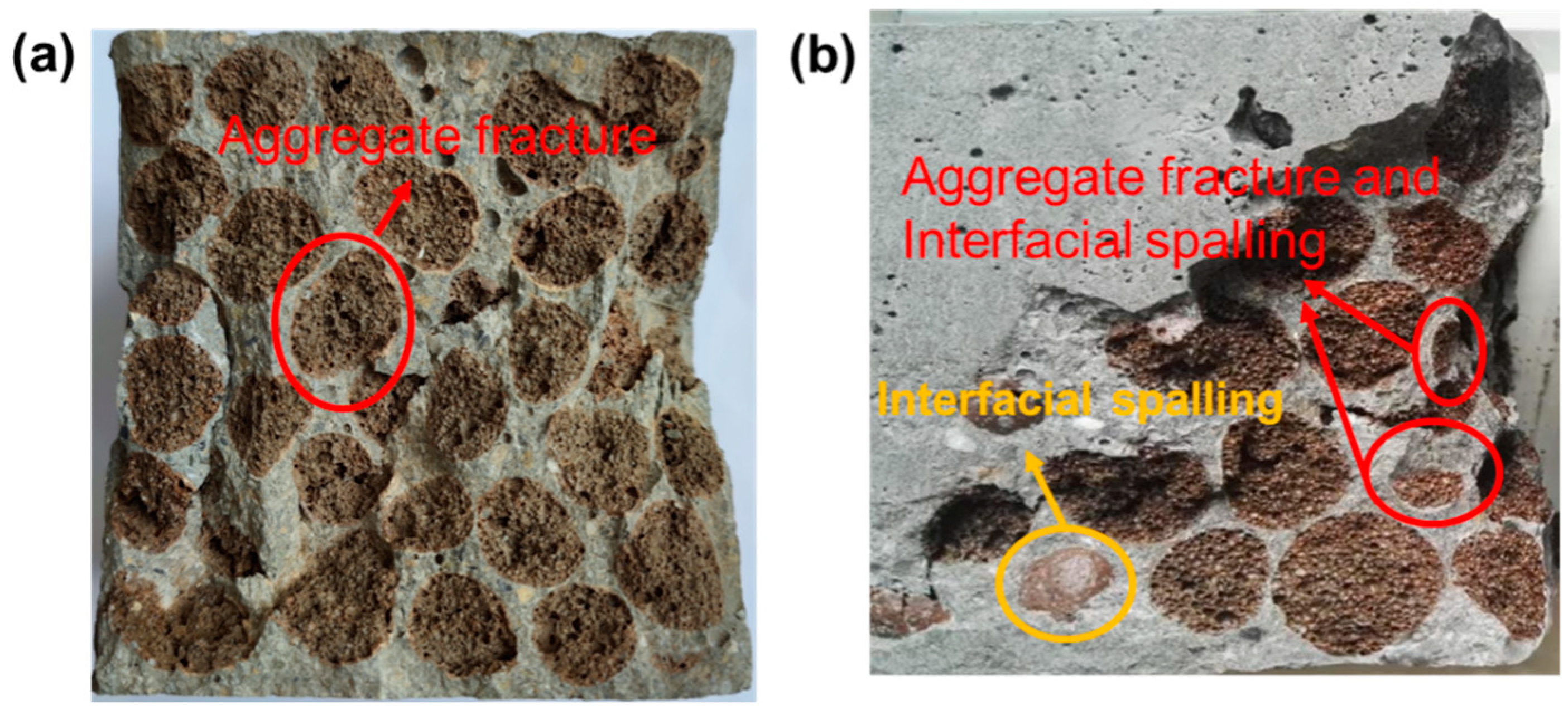
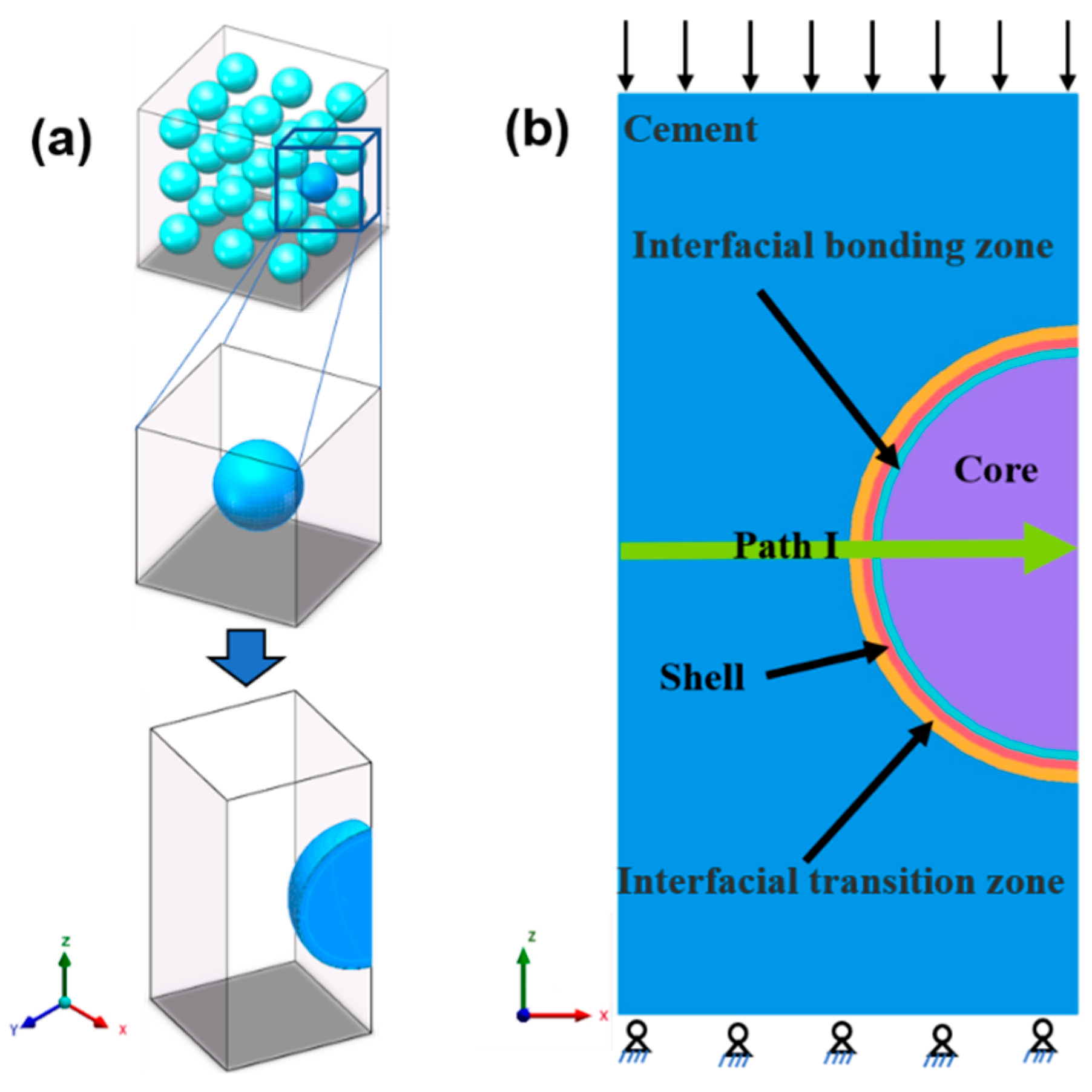

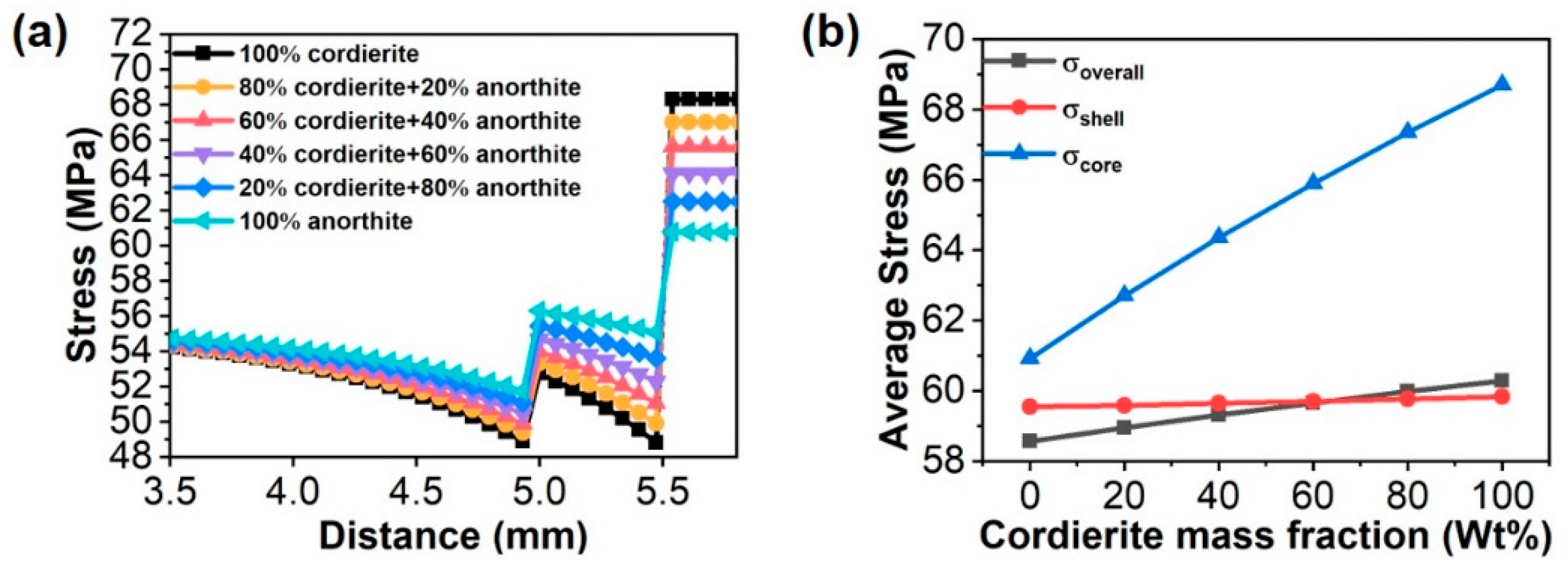
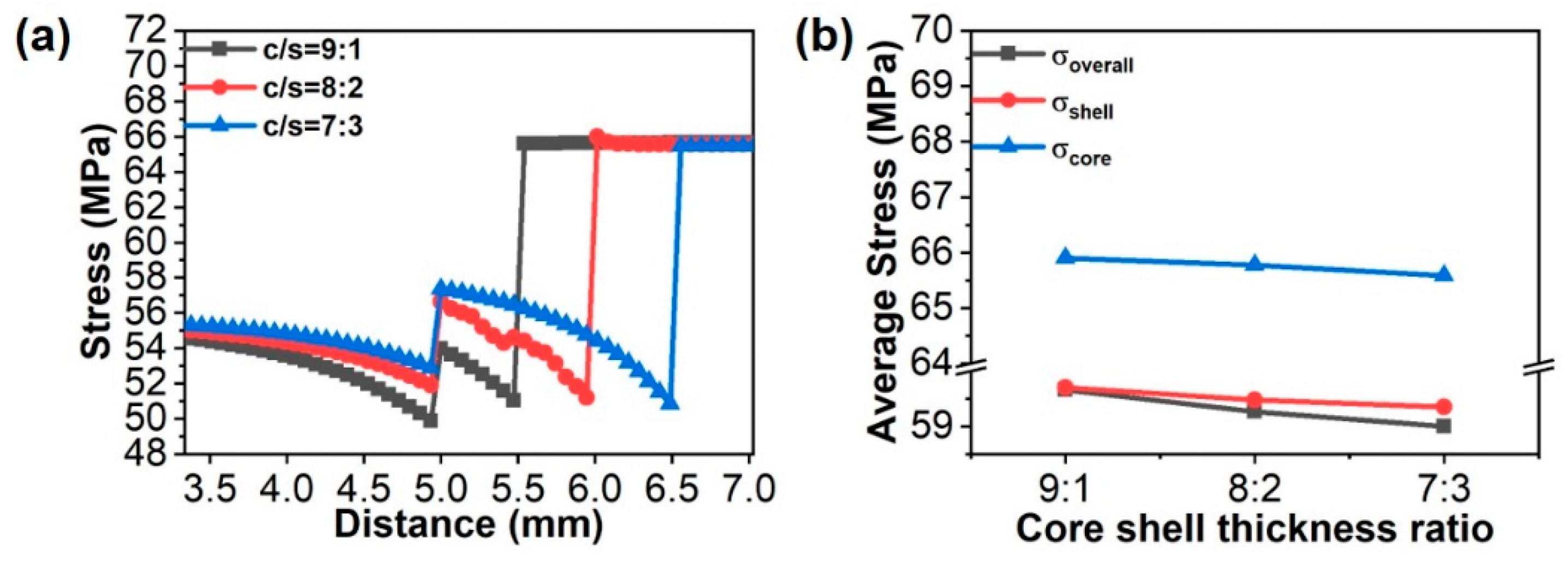
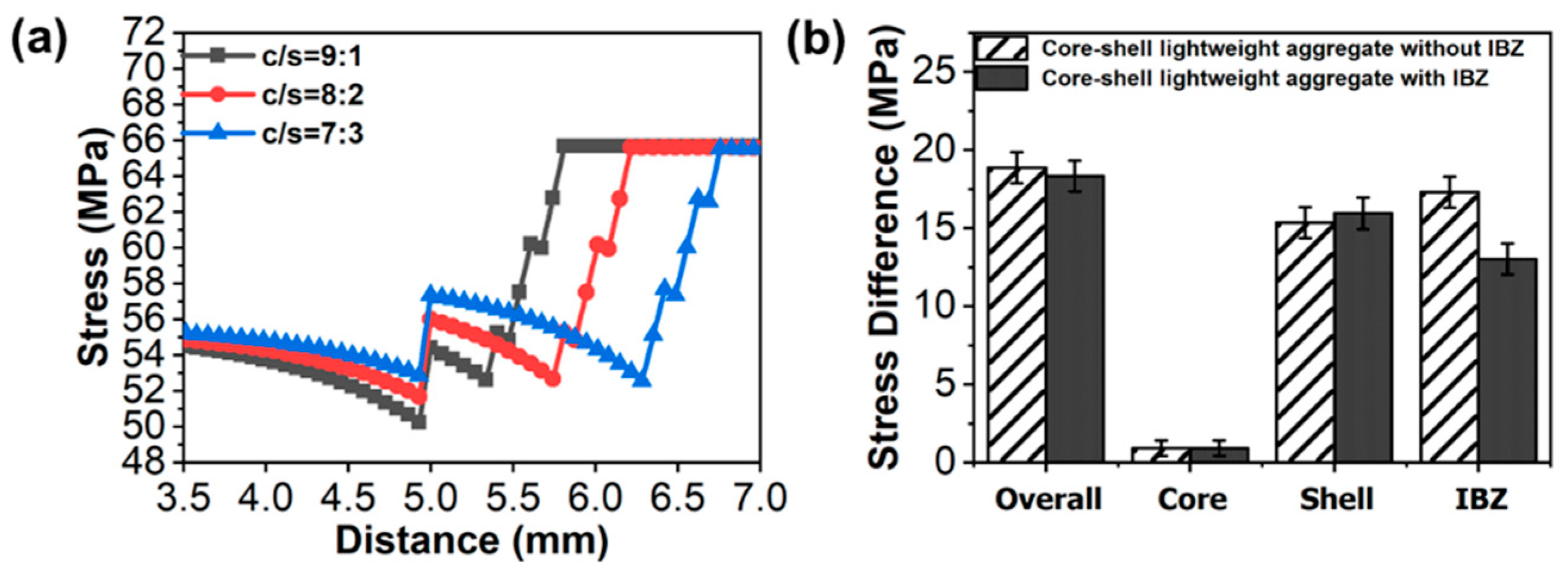
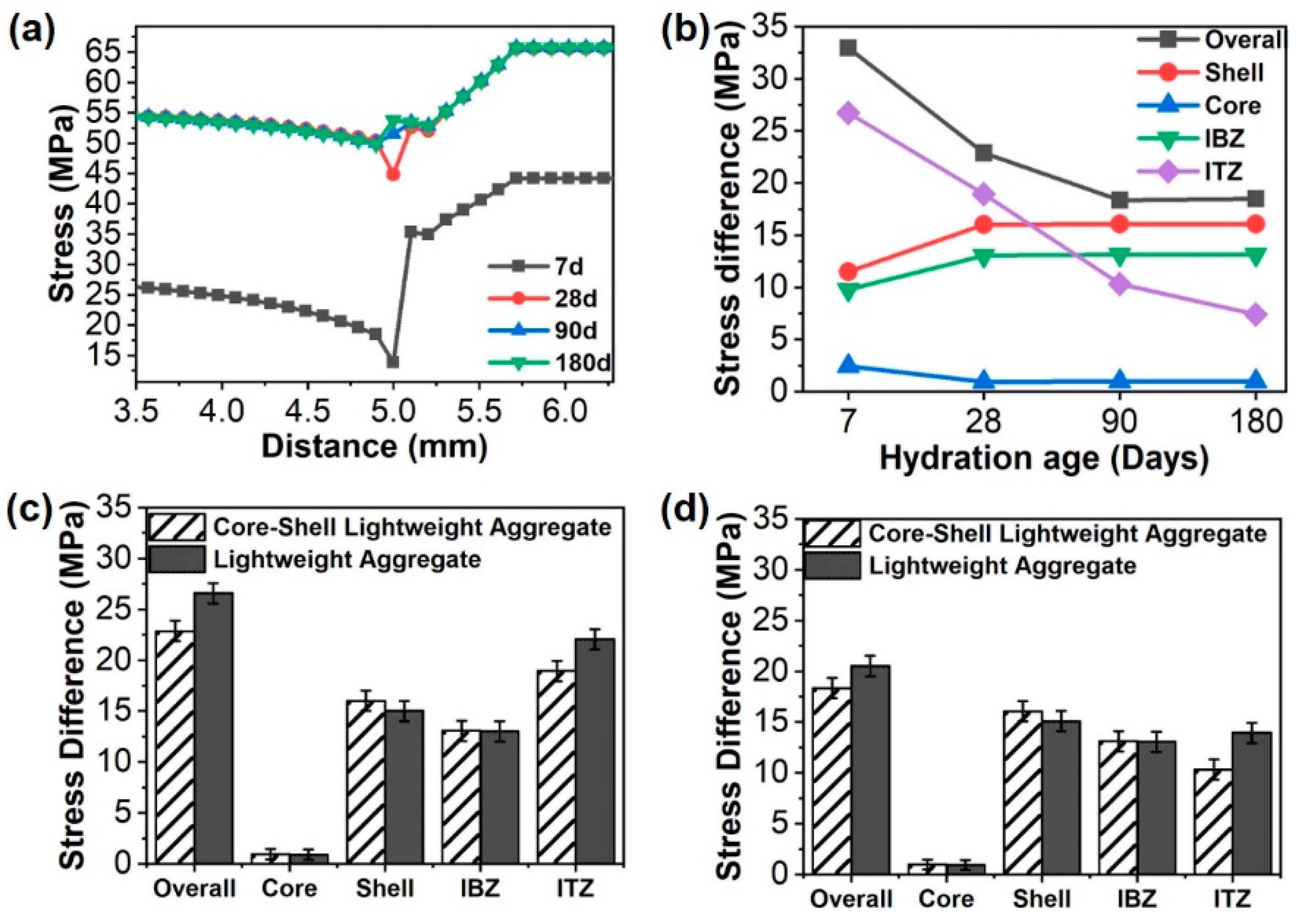
| Density (g cm−3) | Young’s Modulus (GPa) | Poisson’s Ratio | |
|---|---|---|---|
| Cordierite | 2.30 | 125.0 | 0.26 |
| Anorthite | 2.77 | 99.1 | 0.30 |
| Unhydrated Particles | 135 | 0.27 | |
| Hydration Products | 25.0 | 0.20 |
| Cordierite Content (wt.%) | 100 | 80 | 60 | 40 | 20 | 0 |
|---|---|---|---|---|---|---|
| Young’s modulus (GPa) | 34.375 | 33.024 | 31.642 | 30.224 | 28.763 | 27.253 |
| Poisson’s ratio | 0.26 | 0.27 | 0.27 | 0.28 | 0.29 | 0.3 |
| Performance density (kg m−3) | 2.300 | 2.381 | 2.467 | 2.561 | 2.661 | 2.770 |
| Hydration Age (Days) | 7 | 28 | 90 | 180 | |
|---|---|---|---|---|---|
| Cement Matrix | Young’s modulus (GPa) | 11.200 | 22.300 | 22.300 | 22.300 |
| Poisson’s ratio | 0.33 | 0.25 | 0.25 | 0.25 | |
| Belite Shell | Young’s modulus (GPa) | 23.655 | 23.682 | 23.965 | 23.964 |
| Poisson’s ratio | 0.23 | 0.21 | 0.20 | 0.20 | |
| ITZ of CSLWA | Young’s modulus (GPa) | 8.960 | 20.070 | 23.415 | 24.530 |
| Poisson’s ratio | 0.264 | 0.28 | 0.280 | 0.30 | |
| ITZ of ordinary light aggregate | Young’s modulus (GPa) | 8.765 | 18.349 | 21.408 | 22.541 |
| Poisson’s ratio | 0.264 | 0.28 | 0.28 | 0.30 | |
Publisher’s Note: MDPI stays neutral with regard to jurisdictional claims in published maps and institutional affiliations. |
© 2021 by the authors. Licensee MDPI, Basel, Switzerland. This article is an open access article distributed under the terms and conditions of the Creative Commons Attribution (CC BY) license (https://creativecommons.org/licenses/by/4.0/).
Share and Cite
Zhu, M.; Zhang, L.; Wang, W.; Zhang, H.; Xing, W. Stress Distribution in Microregion of Core–Shell Structure Lightweight Aggregate Concrete. Buildings 2021, 11, 540. https://doi.org/10.3390/buildings11110540
Zhu M, Zhang L, Wang W, Zhang H, Xing W. Stress Distribution in Microregion of Core–Shell Structure Lightweight Aggregate Concrete. Buildings. 2021; 11(11):540. https://doi.org/10.3390/buildings11110540
Chicago/Turabian StyleZhu, Meng, Lihua Zhang, Weilong Wang, Hongping Zhang, and Wenjin Xing. 2021. "Stress Distribution in Microregion of Core–Shell Structure Lightweight Aggregate Concrete" Buildings 11, no. 11: 540. https://doi.org/10.3390/buildings11110540
APA StyleZhu, M., Zhang, L., Wang, W., Zhang, H., & Xing, W. (2021). Stress Distribution in Microregion of Core–Shell Structure Lightweight Aggregate Concrete. Buildings, 11(11), 540. https://doi.org/10.3390/buildings11110540





